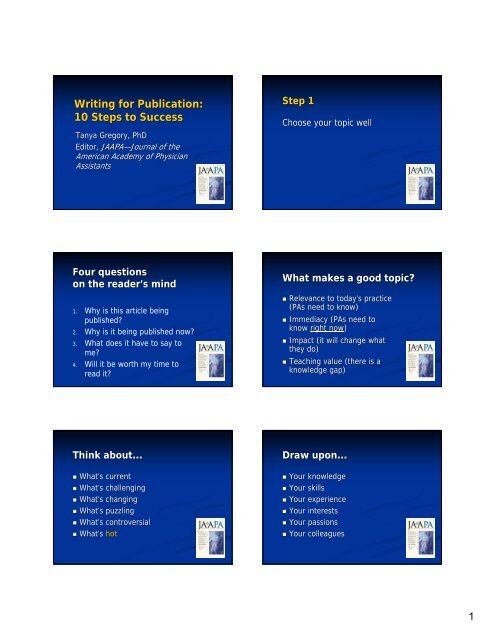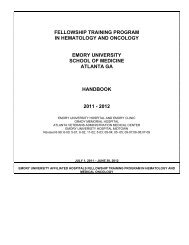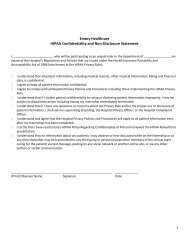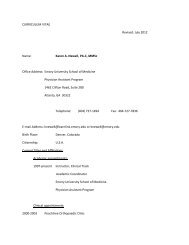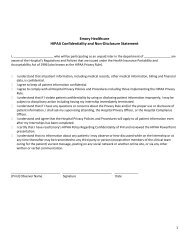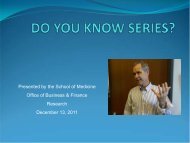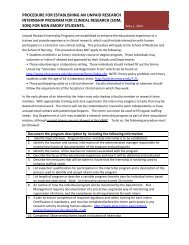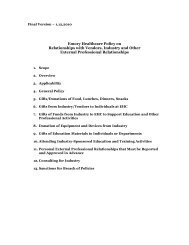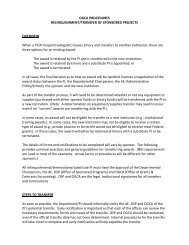PDF of Tanya Gregory's Slides
PDF of Tanya Gregory's Slides
PDF of Tanya Gregory's Slides
- No tags were found...
You also want an ePaper? Increase the reach of your titles
YUMPU automatically turns print PDFs into web optimized ePapers that Google loves.
Writing for Publication:10 Steps to Success<strong>Tanya</strong> Gregory, PhDEditor, JAAPA—Journal Journal <strong>of</strong> theAmerican Academy <strong>of</strong> PhysicianAssistantsStep 1Choose your topic wellFour questionson the reader’s mind1. Why is this article beingpublished?2. Why is it being published now?3. What does it have to say tome?4. Will it be worth my time toread it?What makes a good topic?• Relevance to today’s practice(PAs need to know)• Immediacy (PAs need toknow right now)• Impact (it will change whatthey do)• Teaching value (there is aknowledge gap)Think about…• What’s current• What’s challenging• What’s changing• What’s puzzling• What’s controversial• What’s hotDraw upon…• Your knowledge• Your skills• Your experience• Your interests• Your passions• Your colleagues1
Focus the topic• ADHD• ADHD in adults• Treatment <strong>of</strong> ADHD in adults• Drug treatment <strong>of</strong> ADHD inadults• Cardiovascular risks <strong>of</strong> drugtreatment <strong>of</strong> ADHD in adultsTip for success• Your article should be useful,interesting, , or enjoyable to read• It needs to be only one <strong>of</strong> the three• If it is none <strong>of</strong> the three, no onewill want to read itA special caseWhat if you’re a student?Tips for success• Choose a department, not afeature• Write out <strong>of</strong> your experience• Remember the teachablemoment that worked for youas a student, and share itwith your audienceThis means….• Don’t write a clinical review article• If you want to write a feature-length article, consider a CaseReport• Or, choose a case-baseddepartment, such as Case <strong>of</strong>the Month or Derm DigestOr….If you were asked to pose a clinicalquestion and then research theliterature to answer it …consider reworking yourpaper into a CAT Clinic2
Finally….Remember that whateveryou wrote as a studentwill have to be revised andreworked to fit thejournal’s guidelines andrequirementsStep 2Research your target publicationTip for successLook at recent issues <strong>of</strong> thejournal you want to write for• Notice the types <strong>of</strong> articlesthat appear• Don’t just skim—read some <strong>of</strong>the articles, especially if youaren’t a regular reader<strong>of</strong> the publicationTry to write your article so it fitsthe parameters <strong>of</strong> what that journaltypically publishesNotice the tone and style• Is it conversational—an an authorspeaking directly to the reader withthe use <strong>of</strong> first and second person?• Is it formal and academic?• Somewhere in between?3
When you write, try to imitate thesame tone and styleNotice the length <strong>of</strong> articlesMake your article about as long, orabout as short, as what the journalusually publishesLook to see whether accessories(tables, photos, algorithms,imaging studies, etc) are includedTip for successProvide, or suggest, similaraccessories for your articleRead the author guidelines4
Step 3The guidelines will describe the types<strong>of</strong> articles the publication wants,what the requirements are, and howto prepare a manuscriptUnderstand the writing processThe writing process• Choose a topic and develop a schedule• Do your research• Organize your information and write anoutline• Write a rough draft• Let it sit• Revise and finalize• Pro<strong>of</strong>readContemporary medicalwriting“What’s up with the FDA lately? Theregulatory agency seems to have beenin the news repeatedly as one high-pr<strong>of</strong>ile drug after another getsremoved from the market or hasa new ‘black box’ warning addedto its labeling.”Where did it appear?• JAMA• JAAPA• GQ• Ms.• O (The Oprah Magazine)Remember ….• Medical writing doesn’thave to be boring or dry• It can be rhetoricallyinteresting, even elegant5
Wolff-ParkinsonParkinson-Whitesyndrome (before editing)“The Wolff-ParkinsonParkinson-White syndrome isdefined as an electrocardiographic patternin which the QRS morphology is determinedby atrioventricular (anterograde)) conductionfrom both the atrioventricular nodeand an atrioventricular accessorypathway, or Kent bundle.”Wolff-ParkinsonParkinson-Whitesyndrome (after editing)“Wolff-ParkinsonParkinson-White syndrome is a structuralcongenital heart defect that affects people <strong>of</strong>all ages, <strong>of</strong>ten unpredictably, by virtue <strong>of</strong> itsinfluence on cardiac conduction. It is rarelylethal, occasionally sociallydebilitating, and frequentlya nuisance.”Remember: Less is moreTombstone in Boot Hill Cemetery,Tombstone, ArizonaHere LiesLester Moore4 slugs from a .44No LesNo MoreThe most importantdistinction• What you want to sayversus• What the reader needs toknowNo one said it was easy!“A writer is someone for whomwriting is more difficult than it isfor other people.”- Thomas Mann“You can’t wait for inspiration.You have to go after it with aclub.”- Jack LondonWhat’s the hardest part?Tom Stoppard said:“The hardest part is gettingto the top <strong>of</strong> page 1.”6
Above all, maintain hopeSarah Zarbock said:“The hardest thing aboutwriting is applying theseat <strong>of</strong> your pants to theseat <strong>of</strong> your chair”“The beautiful part <strong>of</strong> writing is that you don’t have toget it right the first time — unlike, say, a brain surgeon.”- Robert Cormier“There is no great writing, only great rewriting.”- Justice Louis Brandeis“You miss 100% <strong>of</strong> the shots you don’t take.”- Walter Gretzky (Wayne’s dad)Who says editing isn’t fun!• Man has been interested insex ever since he discoveredthe use <strong>of</strong> his hands.Step 4Avoid plagiarism• John left clinical practice toassume a missionaryposition.Some definitionsYou are plagiarizing if you fail to giveacknowledgement when1. Repeating another’s words (or even aparticularly apt term)2. Paraphrasing another’s argument3. Presenting another’s line <strong>of</strong>thinking(MLA Handbook, , 4th ed)Another definitionPlagiarism is passing <strong>of</strong>f anotherperson’s work as if it were your own:1. failing to cite quotations and borrowedideas2. failing to enclose borrowed language inquotation marks3. failing to put summaries andparaphrases in your own words(Wikipedia, the free encyclopedia)7
A final definitionYou are plagiarizing if you fail to givecredit whenever you use1. another person’s idea, opinion, or theory2. any facts, statistics, or other pieces <strong>of</strong>information that are not common knowledge3. quotations <strong>of</strong> another person’sactual words4. paraphrases <strong>of</strong> another person’swords(Indiana University Writing Tutorial Services)Some plagiarism is intentionalBUTA lot <strong>of</strong> plagiarism happens“by accident”—throughthroughignorance, laziness, or badhabitsStrategies to avoidplagiarismPut quotation marks aroundeverything that comes directlyfrom a sourceMore strategiesWhen you paraphrase, make sureyou are putting the informationentirely into your own wordsLast but not leastCheck your paraphrase againstthe original text to make sureyou haven’t “accidentally”copied words or phrasesStep 5Follow the author guidelines whenyou prepare your manuscript8
Or….If the manuscript is already written,revise it to comply with thesubmission guidelines before yousend it to the editorYou may want to publish… a master’s paper, adoctoral thesis, a paper thatwas prepared for a class, ora manuscript that wasprepared originally for adifferent journalTip for successAlways revise such documents tomeet the needs and requirements<strong>of</strong> your target journalStep 6Understand how to navigate thepeer review processDo’s and don’ts• You do NOT have to makeevery change reviewers havesuggested• Sometimes peer reviewersare wrong, and sometimestheir comments are just nothelpfulMore do’s and don’ts• Do make the changes thatare reasonable and consistentwith your purpose in writingthe article• Do explain to the editor anychanges you have chosen notto make9
Step 7Be prepared to reviseRevision is SOP• Almost all JAAPA authors areasked to make revisionsbased on the peer reviewers’comments• Most medical journals havemanuscripts reviewed and askauthors to reviseStep 8Expect your manuscript to changeduring editingThe editor’s job is to edit• The less well-written written themanuscript, the moreaggressively it will be edited• Even a well-writtenwrittenmanuscript will be edited tomatch the needs, style, andformat <strong>of</strong> the publicationStep 9Be a responsive and responsibleauthorTips for success• Learn about the publication’sproduction process anddeadlines• When the editorial staff asksyou to do something, do itquickly10
Step 10Work with the editor as effectivelyas possibleTip for success• Understand that the editor wearsdifferent hats• This means: helping the author lookgood in print is only one part <strong>of</strong> theeditor’s jobThe other parts• The editor is also responsible to thereaders and to the publication’smission• An editor must make a manuscript fitthe mission and make sure thatreaders will want to read itHowever….The editor does expect —and welcome — a give-andand-takewith authorsEditors are reasonable peopleIf you feel strongly aboutcertain things—how how somethingis phrased, whether an elementis omitted or included—mosteditors will negotiateFinally….• Don’t expect to get everythingyou want• But do expect to get a compromiseyou can live with11
Thank you• JAAPA author guidelines are availableonline at www.jaapa.com• E-mail the editor at jaapa@aapa.org12


